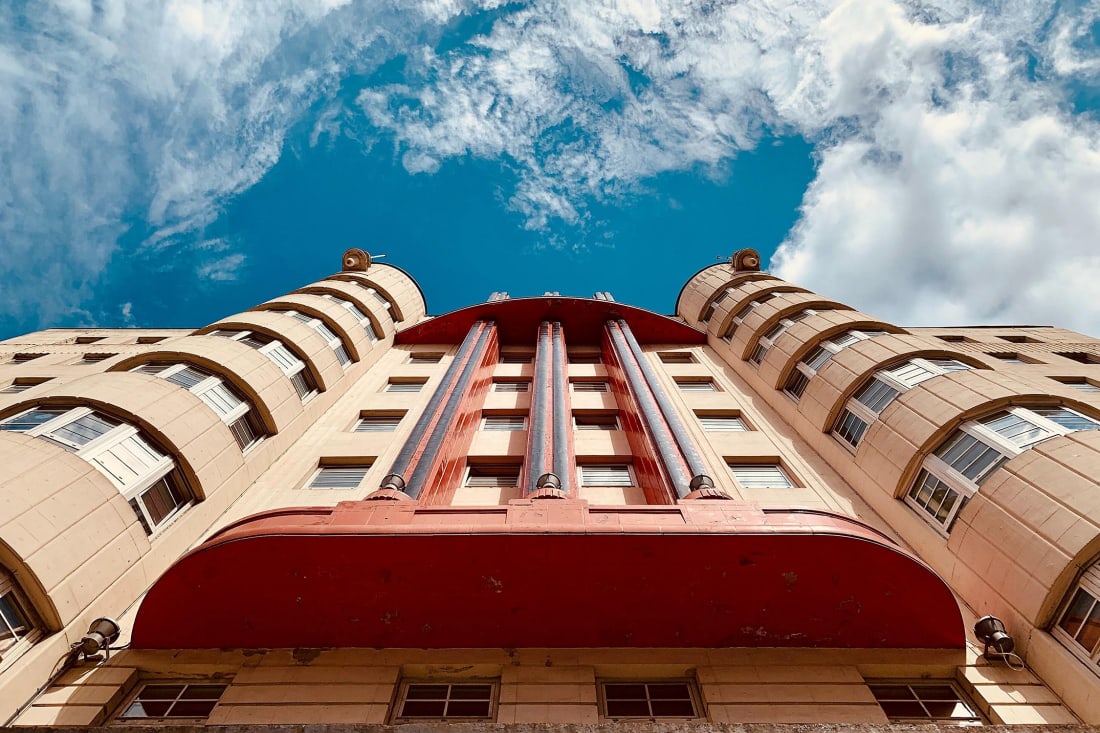What to do in Tbilisi: dogs, wine, khachapuri and techno
From cheesy bread to chacha shots, here’s why the Georgian capital should be your next city break
From cheesy bread to chacha shots, here’s why the Georgian capital should be your next city break
Your no-nonsense travel guide to Tbilisi
As you wander through Tbilisi, don’t be surprised if you accumulate an entourage of street dogs. The thousands of tagged strays that roam the Georgian capital have become part of the city’s charm, much like its eclectic architecture, street art and nightlife. Georgia, which sits at the border between Europe and Asia, is the birthplace of wine and claims the first recorded existence of humans in Europe. These facts alone are reason enough to make its capital city, Tbilisi, your next city break, but more recently it has gained an edgy reputation thanks to its vibrant nightlife scene and status as a burgeoning fashion capital. Fashion designer Demna grew up there, while Bassiani, the 1,200-capacity techno club in a disused swimming pool, is Georgia’s answer to Berghain. But essentially, if you like cheesy bread and cheap dinners – who doesn’t? – then Tbilisi is the place to be. I recently visited on a group trip with friends and here's what we got up to during our five day stay.
Getting to Tbilisi
Georgia is a transcontinental country bordered by Russia, Azerbaijan, Turkey and Armenia. This means the biggest faff of visiting Tbilisi is getting there, as there are currently no direct flights from the UK. On the plus side, the layover means you can tick an extra destination off your list, if you count sprinting through the airport or experiencing a claustrophobic smoking area as having visited a place. Most connecting flights change in Turkey, so we flew 4 hours to Istanbul then another 2 hours to Tbilisi. This makes the total time it takes to get from London to Tbilisi around 7 and a half hours. The flight time is roughly the same from any city in the UK.
Where to stay in Tbilisi
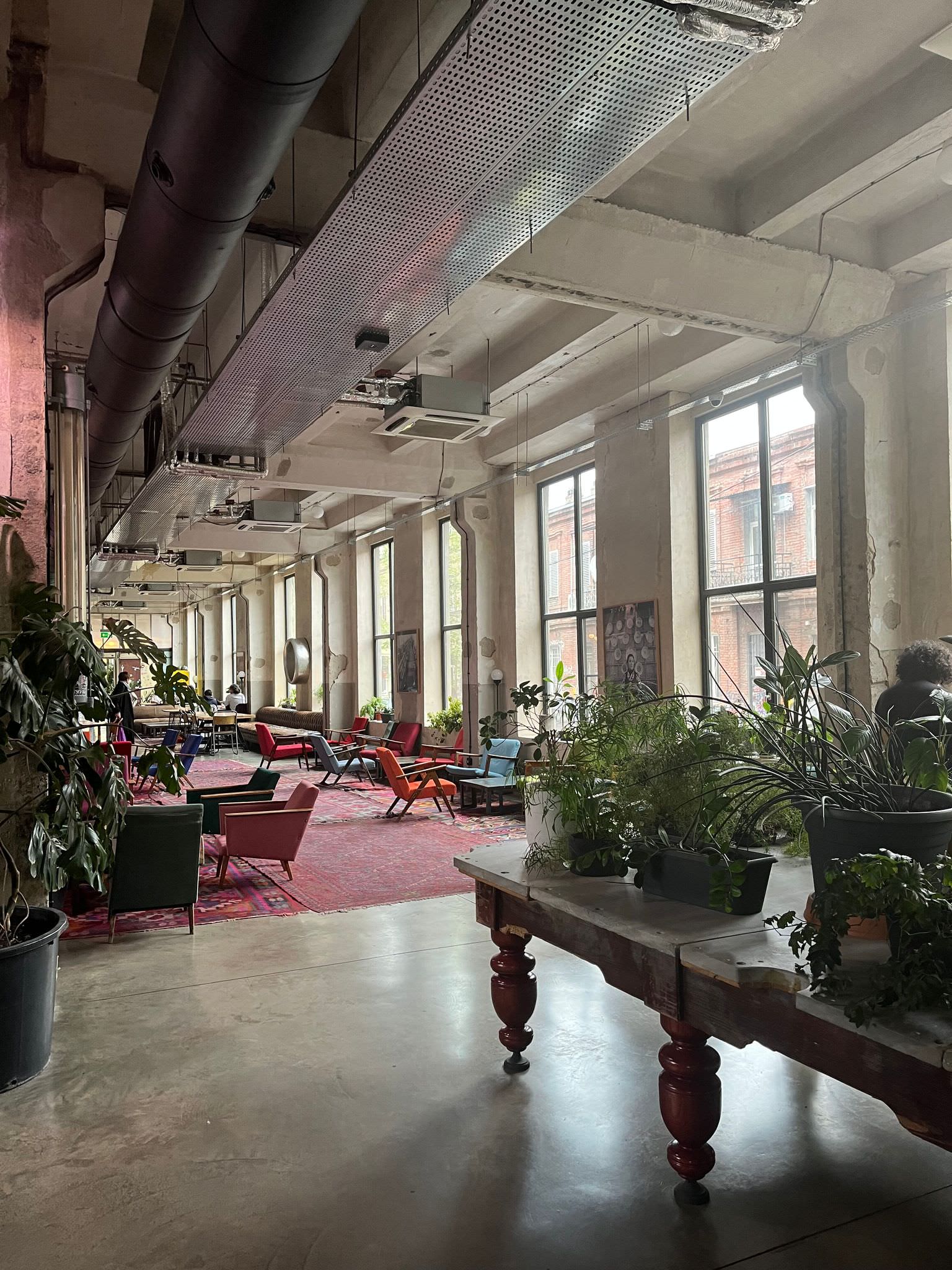
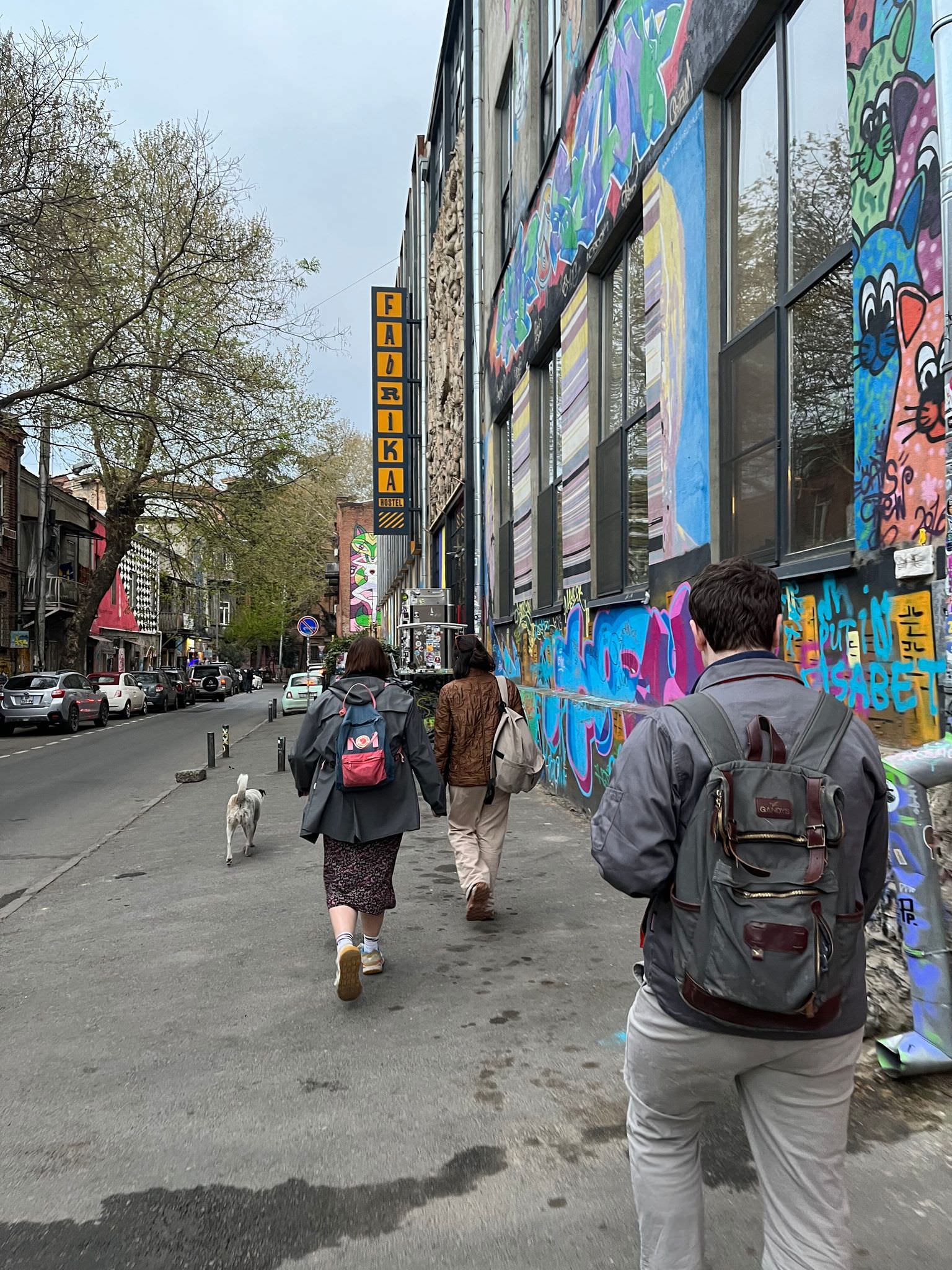
As hotels and Airbnbs battle it out over where is best for city stays, we often overlook the humble hostel. Perhaps that's down to past experiences on cramped bunk beds and sharing rooms with strangers who talk in their sleep, but Tbilisi's answer to a hostel is much more chic. **Fabrika is inside a converted Soviet sewing factory that now attracts tourists and expats from all over the world. It contains a club, bar and a coworking space as well as a creepy temperamental lift to take you up to the rooms.
Behind the building you’ll find lively bars and restaurants where you can meet other tourists visiting the city as well as locals who flock to the area to soak up its bustling atmosphere. If you’re travelling on a budget, Fabrika’s 12-person dorms are only £7.25 per night and you can upgrade to a private double room for just £29 per night. The private rooms are nicer than most hotels and come with expansive balconies and lots of living space. However, if you do decide to rent an Airbnb, you can easily find a two person apartment for less than £50 per night. Meanwhile, hotel prices range from as little as £10, but the average cost is around £99 per night.
Coffee and breakfast in Tbilisi


Love cheesy bread? I've got good news for you. In Tbilisi you can eat khachapuri – Georgia’s famous cheese-filled bread – for breakfast, lunch and dinner if you want to. They’re so filling that each time you finish one, you’ll tell yourself you can never even look at another khachapuri again, but then you’ll order three for the table at your next meal anyway. So, when it comes to breakfast food, you can head to one of the city’s many traditional bakeries to sample various khachapuri or try a Soviet donut if you're in the mood for a sweet treat.
For coffee in the sun pay a visit to Slink Cafe in Ilia Garden, a greenhouse with outdoor seating that serves familiar brunch food like avocado on toast and stuffed croissants. And if you like to get started with sightseeing in the morning without having a full breakfast, you can always pick up some pomegranate juice or wine flavoured ice cream from a roadside stall. After all, if you can’t have wine ice cream for breakfast when you’re on holiday, then when can you?
Restaurants in Tbilisi


Once you’ve finished your breakfast khachapuri, it’s time to start thinking about what you’re having for lunch. And you won't be short on options. For homemade khinkali – Georgia’s traditional dumplings filled with meat, cheese or mushrooms – try Anthony Bourdain-approved Sofia Melnikova’s Douqan. The minimum order of each filling is 5 dumplings so it's best to order your khinkali to share – along with a side of khachapuri, of course. For tasty lunchtime sandwiches, head to Roosters and make sure you dip your fries in satsebeli, a Georgian sauce made from tomato paste, garlic, adjika chilli paste and a mix of traditional Georgian spicy herbs. As dinner time rolls around, check out Kutkhe for an insanely affordable meal of khinkali and khachapuri with wine in a cosy underground cellar – we paid £7 each for three courses including two bottles of wine. Or sit down at Saghighino to try their aubergine walnut dish and the best khachapuri in Tbilisi, according to locals.
While eating out in Tbilisi, be prepared for your food to arrive at different times. Don’t be surprised if you’ve finished your food by the time your friend’s meal arrives. Fortunately, this waiting time gives you ample opportunity to drink Georgian wine. Wine was invented in Georgia some 8,000 years ago and wine making is still serious business there. If you’re feeling brave (or getting ready to go out out) order some Georgian chacha as a digestif. Home brewed chacha can be as strong as 85% alcohol, but the shots you get out are between 40% and 50% so it still packs a punch. The shot is sometimes served with a slice of orange which can be squeezed into the drink before you knock it back, or sucked afterwards like a post-tequila lime. Look out for chachacello, a Georgian version of limoncello which tastes sweeter and isn't as strong. For sober visitors who still want to try a traditional beverage, Georgian lemonade is the way to go. Most restaurants serve their own homemade recipe with mint, but you can also buy it bottled in flavours ranging from pear to tarragon.
Everyone knows that checking out the offerings at fast food chains in another country is a core part of the local experience. Tbilisi’s Dunkin’ Donuts offer a selection of khachapuri as expansive as most of the traditional bakeries. McDonald's isn't quite as exciting, but the burgers all came as doubles and you can try them with some 'bittersweet' sauce. Seeing as the base of Georgian cuisine is cheese and bread, it’s pretty vegetarian friendly. Obviously, this makes it a bit harder for vegans, but aubergine and bean based dishes served with walnuts or pomegranate seeds are popular. However, it's worth checking menus ahead of time if you have specific dietary requirements.
What to do in Tbilisi

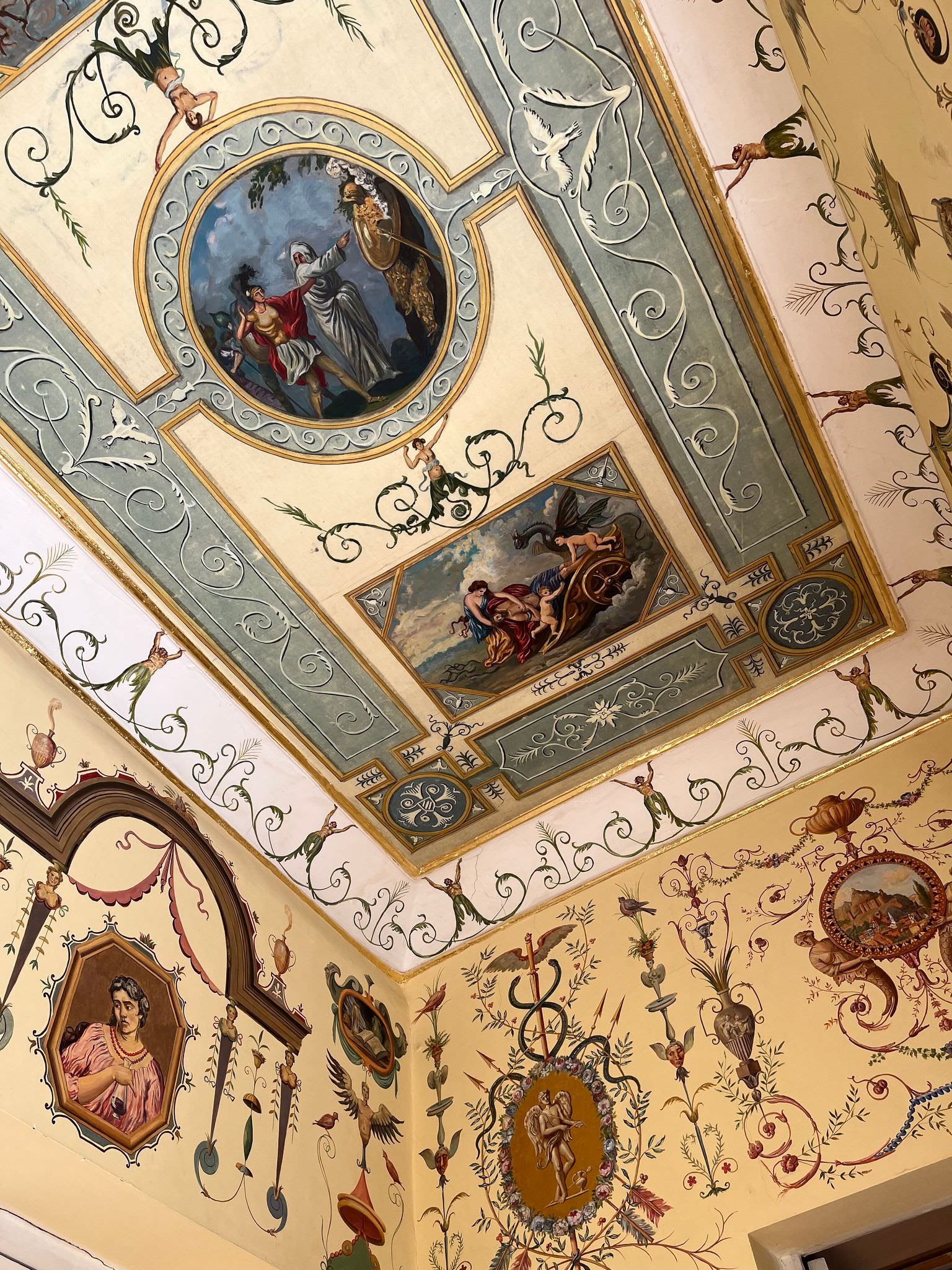
We don’t blame you if you want to spend most of your time in Tbilisi eating and drinking, but there’s only so much khachapuri you can eat before you start thinking about walking it off. If you fancy a post-lunch workout, climb up to Narikala fortress and take in the views of the city. You can also climb the ancient fortress itself for some stunning city views and photo ops. But if steep uphill climbs aren’t your thing, you can still get a gorgeous view of the city by riding the funicular to Mtatsminda Theme Park or taking the cable car up to Turtle Lake.
For art and museums, check out Art Palace for an expansive art and cultural history ranging from 17th Century Western European portraits to historical Georgian dress and modern illustrations. Georgia is home to some of the oldest humans in Europe. Remains found in the town of Dmanisi date back 1.8 million years. The National Museum combines this ancient history with modern artefacts exploring the country's Soviet past while the Open Air Museum of Ethnography documents how Georgians lived in previous centuries including the architecture of old houses and how food was made and stored. Tbilisi also contains many abandoned buildings and brutalist architecture which you can take in yourself or book onto a tour to learn more about.
The best clubs and bars in Tbilisi


Techno lovers unite! If you’re going out out in Tbilisi, you simply have to go to a techno club. In bars, you can find live music in a wider array of genres, but dark smoky techno raves are the thumping heart of Tbilisi nightlife. Bassiani is the most famous, a sprawling club in a former sports centre. The main dance floor is in an empty swimming pool. It’s basically Tbilisi’s answer to Berghain, with a strict entry policy to match. We spoke to a bartender who told us he tried to get into Bassiani on five separate occasions before finally being allowed in which sounded like a lot of effort. Plus, a local told us it was “too mainstream” – the horror!
Deciding against it, we wandered down to riverside techno venue Left Bank which stays open until 9am on weekends. We still had to stare into a camera at the door to get in, but we arrived just before midnight so it was early enough that we had no issues. Boasting a sizeable smoking area, darkly lit main room and a smaller room in a building that feels like a church, it’s the kind of place you can spend chacha-fuelled hours dancing and making friends, but our legs were tired from sightseeing so we didn’t make it to 9am. Mutant Radio, which is conveniently located just down the road, is the perfect place for a pre-drink or a more chilled night. Mutant Radio refers to an active radio station and media platform operating from a caravan near the bar.
The best vintage shops in Tbilisi

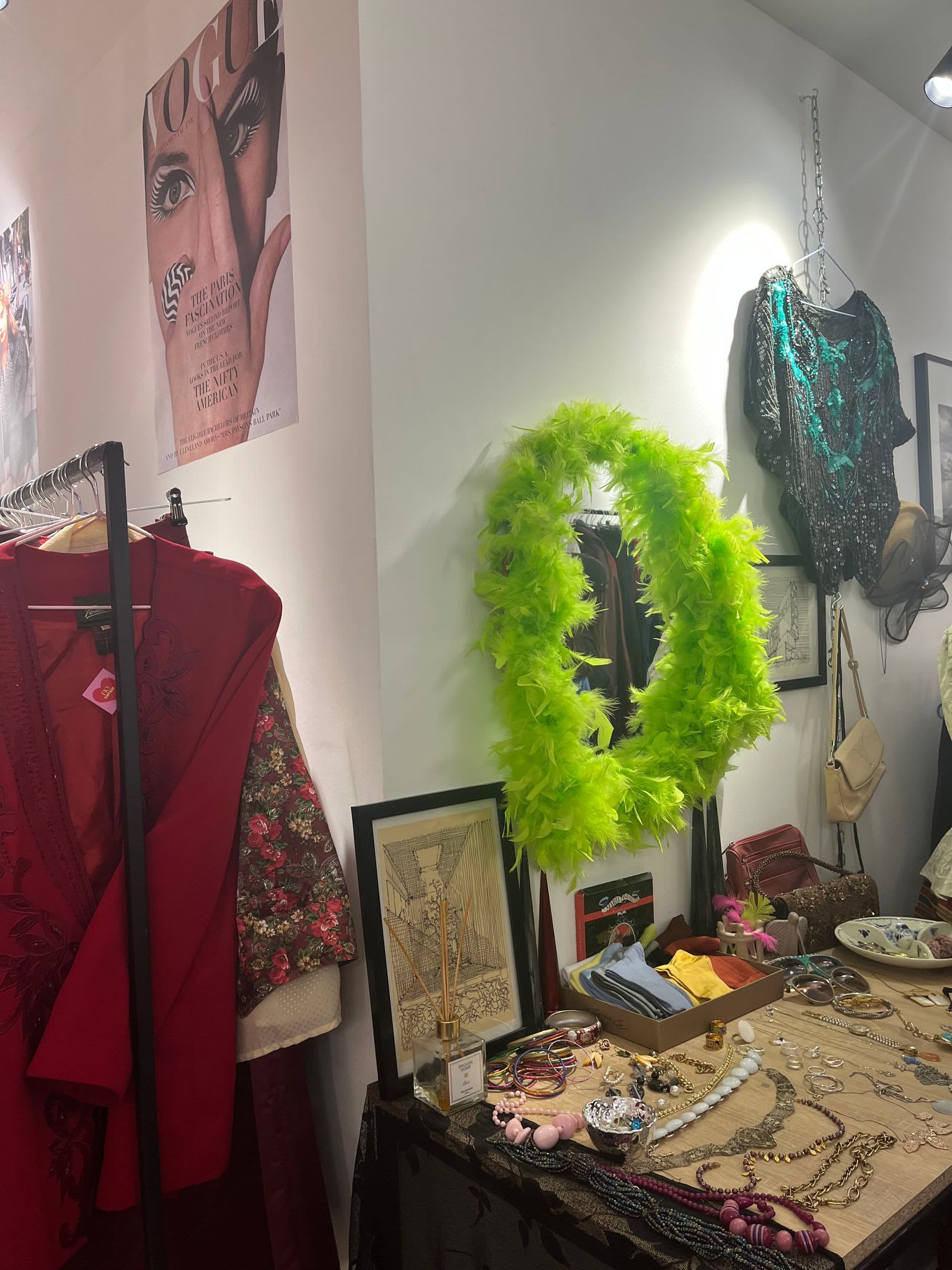
In the past decade, Tbilisi has emerged as a new fashion capital, launching its own official Mercedes Benz Fashion Week in 2015. Georgian native Demna, creative director at Balenciaga and co-founder of Vetements, is often credited with elevating its global fashion cred, but the local scene is flourishing thanks to a new gen of trailblazing designers. Irakli Rusadze learnt how to sew from traditional Georgian craftsmen before founding Situationist in 2016 when he was just 17. The brand is still based in Tbilisi and counts Bella Hadid among its fans. Meanwhile Tbilisi-born, London-based David Koma has been designing since 2009, but has become a recent awards show fav among the likes of Beyonce, Olivia Rodrigo and Willow Smith.
Its evolution into a thriving fashion destination means you might be curious about what the vintage shops have to offer. Well, first of all, there are two kinds of thrift stores in Tbilisi. The first are giant warehouses packed with piles and piles of secondhand clothes. You can find these at Dezerter Bazaar or in nondescript buildings around the city. The clothes here are incredibly cheap, but it’s also your chance to haggle. It would be easy to spend an entire day sifting through, if you have the patience. The clothes here aren’t curated so you’d be lucky to find something cool in your size, but if you’re up for the challenge it’s a fun way to spend an afternoon.


Thankfully, if you don’t want to spend too much time sorting through piles of clothes, there are plenty of curated vintage stores to choose from. Dezerter Vintage and Vintage Crush feel more like London's vintage shops, only everything is a fraction of the price. If you’re staying at Fabrika, you have plenty to choose from on your doorstep. Vintage Hub and Vintylator are a little pricier because they’re taking advantage of being in the middle of a hipster tourist hub, but they’re still cheaper than you’d find in the UK. For unique jewellery, look out for the little markets along the pavement where most earrings cost 10GEL (£3). Dry Bridge Market is the biggest one and worth spending a morning wandering around to find some gems. To get a taste of some of the Tbilisi-based fashion brands mentioned earlier, head to IERI, a concept store in Wine Factory that stocks Georgian labels like Situationist, David Koma and Anouki. Just make sure you leave some space in your suitcase when you’re packing because, if you're like me, you'll end up leaving Tbilisi with a whole new wardrobe.
Wellness in Tbilisi


So, dealing with a hangover on a city break. What do you do when you want to make the most of the days while also making the most of the nightlife? It’s an age-old dilemma, but Tbilisi has a solution. If the post-Bassiani blues are kicking in, take a dip in the city’s famous natural sulphur baths – as long as you can stomach the smell; it isn’t too strong, but could be a lot if you’re feeling fragile. The health and wellness benefits of sulphur baths are many. Not only do they help you relax and refresh, but they can also help treat skin problems like eczema and dry scalp as well as soothing arthritic joints, digestion problems and insomnia.
You can visit the gender-segregated public baths or rent a private room. We went with the latter because we were a mixed group and it only cost us £10 each. Housed beneath brick domes, the baths are naturally hot (38-40 degrees celsius), almost uncomfortably so. If you’re feeling particularly rough, proceed with caution. It’s not recommended you spend more than 5 minutes in the hot water at a time. To cool off, there’s an ice plunge pool you can get in for an exhilarating kick. Our room also had a sauna which was the most comfortable temperature of the whole experience. There's also an option to get a massage while you're there.
If you’re staying at Fabrika and want to feel even more relaxed during your stay, they host morning rooftop yoga classes conducted in English. Beginners are welcome and they practise a range of different types of yoga while taking in the stunning city views; the perfect start to a busy day.
Nature in Tbilisi


Much of Tbilisi feels set up for summer where temperatures typically reach around 33 degrees celsius. If you’re visiting in the warmer months, take a cable car up to Turtle Lake where you can take a dip to cool off. You can also head to Mtatsminda Theme Park to ride the log flume.
To experience more of the gorgeous scenery Georgia has to offer, it’s worth booking a day trip out of the city. We decided to take a guided tour of the rainbow mountains and ancient monasteries near the border of Azerbaijan. If you don’t mind scrambling up and down some hills – nearly all of us fell over, but it was hilarious – then it’s well worth the trip. You’ll see the largest herd of sheep you’ve ever seen and probably question whether you should leave your life behind to become a shepherd in rural Georgia. The monasteries were tucked away in caves with Soviet-era graffiti left behind from the occupation while intimate churches contained stunning religious iconography. The day ended with a wine tasting which meant we were the perfect level of tipsy for wistfully taking in the sunset over the hills as we drove back to the city.

